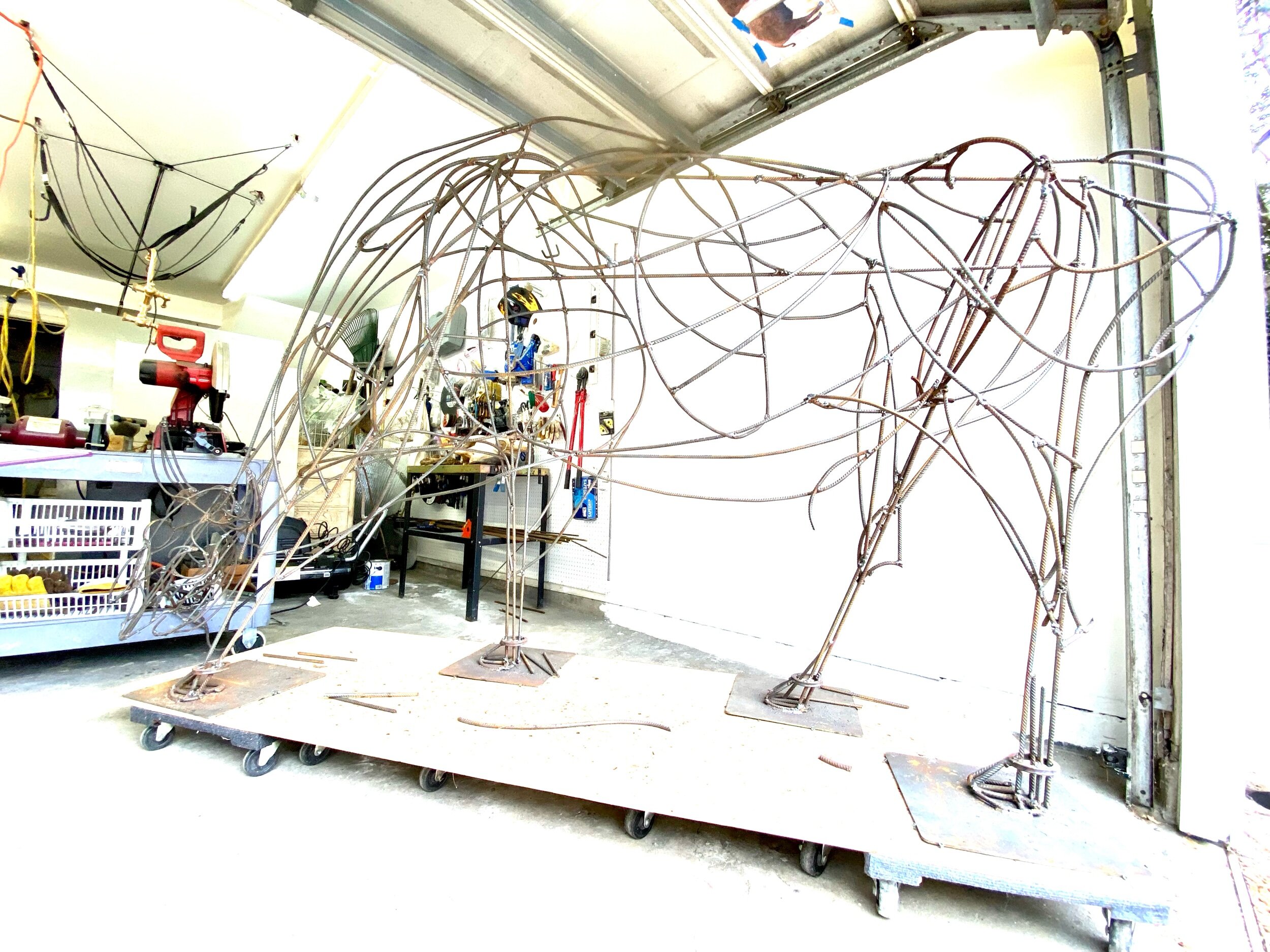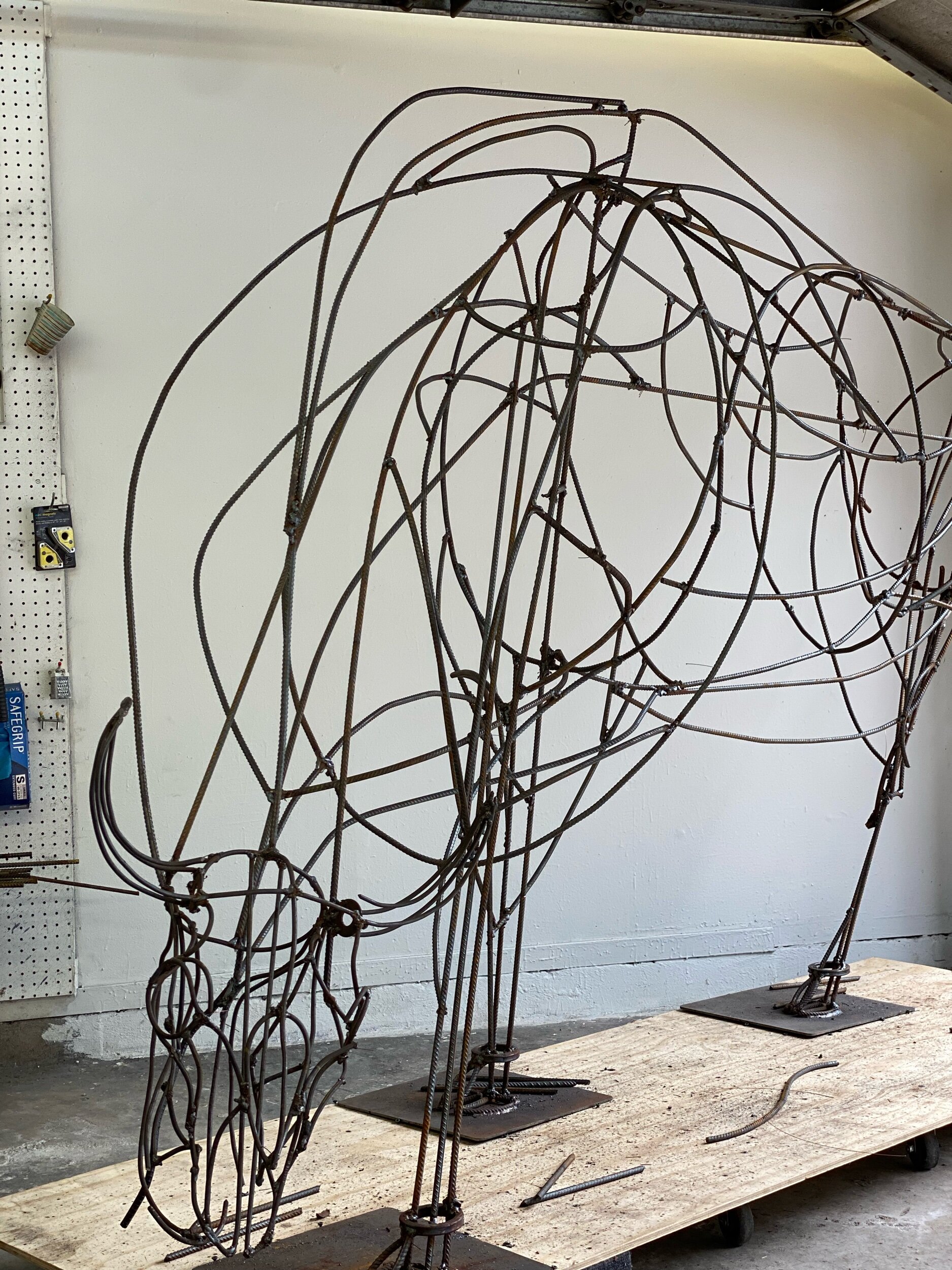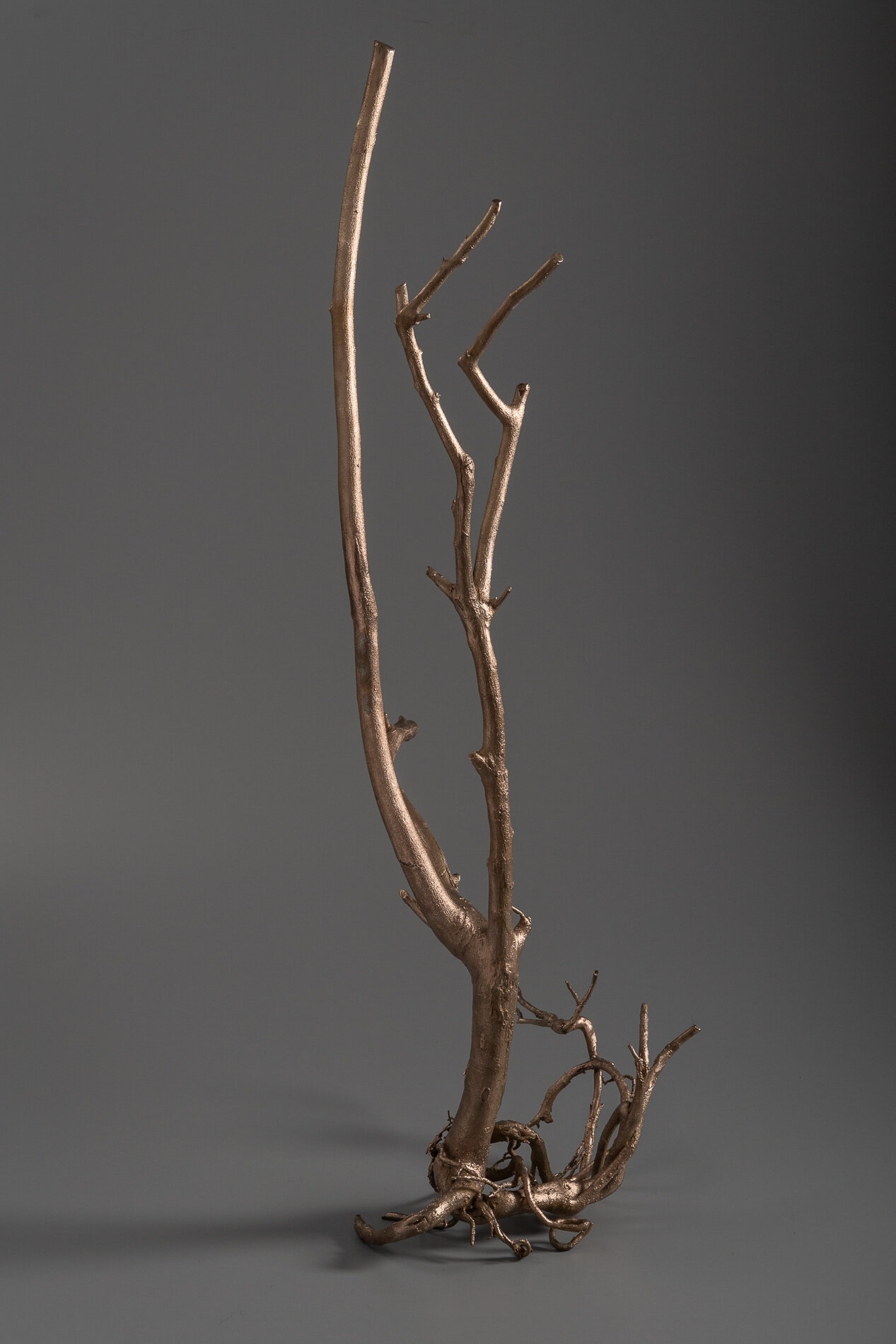Progress from the last two days of work.
Sagged bellie and manhood
Your Custom Text Here
Progress from the last two days of work.


Sagged bellie and manhood

In creating a living sculpture, I have to accept change. I can not control the piece nor do I want to. From soil microbes to leaves, petals and butterflies, bees, skippers and caterpillars, I am always looking to the natural processes. I look to see what does the material want to make, what does it need to be. Competition, succession, disturbance, consumption are the sculpting tools of my collaborator, characteristics of the work. I have to let them follow their path to self-design their regenerating community. I bend my creative processes to the design principles developed through the ages on this planet for this place and time. The time is right to change how we landscape. I believe Houston is the right place and Houstonians the right people to plant the seeds.

Competition

Succession

Disturbance


Consumption
How roots talk to each other. My focus is coastal prairie roots, but I expect roots of grass communicate as tree roots communicate. We gave only begun to learn from roots.

SUBTERRANEOUS SECRETS IV
36” X 8” X 8”
bronze
photo by @nashb Baker
Since the beginning of time, the human spirits' imaginations have been magnetically allured beyond the earth's geomagnetic field, inventing robots, orbiters, landers, and rovers to explore outer space, searching for celestial organisms — fruitlessly.
Secretly between 100 million and 500 billion microbes per teaspoon are living a subterranean life underneath our feet. Living soil is the root of our existence; it is essential to life on Earth. For several years, I have researched grass-fed food production, attended soil conferences, and visited regenerative ranches. (my favorite is @roamranch) Research in these fields reveal how to fight desertification and reverse climate change through regenerative agriculture practices. Interestingly, this natural history of living soil, how it evolved with roots, fungus, plants, food, and animals, carbon and their essential roles within microbial communities in human health, is not common knowledge. Subterraneous Secrets excavates this crucial tool in storing carbon. My work finds new ways to reimagine urban landscapes and records natural history to the collective memory so that it will no longer be endangered knowledge #roamranch #cindeeklementart #bioart #conservationart #environmentalart #root #bronze #bronzesculpture #pesticidefree #texasart #texasartist #houstonart #houstonartist #houstonsculpture #nature #naturalsystems

Bombus Morrisoni II

Bombus Morrisoni II Ghost
I was not happy with the first Bombus Morrisoni so I made more. The first is swimming in violet blooms

Bombus Morrisoni III

Bombus Morrisoni III ghost
Sometime in 2019 or late 2018 I discovered the USGS photographic library of wild bees. I was overwhelmed at the number of species and their individual beauty. They are jewels of the insect world. These facts combined with the reality that most well educated people believe that there is just one bee species - the honey bee. There are 20,000 species. How a creature who is responsible for our food could be misunderstood to this existent is baffling. Scientist just started realizing the error in their studies last summer. Committing to telling the story of the plight of the most important being on the planet is a worthy story. I have always felt the need to support underdogs.
Below us the artist statement for the project as I incusion it today. Artist statements remain fluid as I work on big projects.
RUMBLINGSA rumbling in the distance is nature's way to alert living creatures to their environment. Rumblings; monumentally draws attention to the 20,000 unknown species of threatened wild solitary bees. The bees that can not bee industrialized. The watercolor ink carefully manipulated on the fifty interconnected monotypes to reflect the synergistic, aqueous effect of; the unexplored bee species superior magnetic attraction of golden dust, the movement of the anonymous Keystone species dedication to pollinate, and their fragility due to the applied chemicals that flood industrial agriculture. With Rumblings, there is knowledge and knowledge is power; it is a resounding call to all for action.
The COVID 19 quarantine in March was a huge buzz kill to this series. These are all monotyoes. I use the plexiglass surface to create my water effect that I then press into the paper. I am very attached to this method as the best way to communicate this work for a few reasons. 1. It is a process I created and as far as I know no one else creates monotyoes with this type of mark making., 2. The watery look suggest the use if pesticides that are impacting their extension and lastly the tiny details that make up the bee is suggestive of pollen dust. I have been creating this pieces in MFAH beautiful Glassell studio school printmaking studio. With COVID that us not an option for me.
Since March, I have stitched bees and tried to be open-minded to another process to complete the series. I finally decided to see if I could hand press a 30” X 44” print in my studio.

Here I am applying the ink to the plexiglass. On the wall is a photo of Bombus Dahlbomii, the largest humble bee in the world at 2” long and endangered if it us not already extinct. The photographs are stunning. The photographs are taken if dead bees. In ny pieces, I try to put movement and energy back into the buzz pollinator.


Here I have just pressed the plexiglass with the watercolor ink bee image onto the wet paper. And surprise surprise surprise.

Bombus Dahlbomii IV
I have made three other attempts to print this monsterous fluffy ginger and not been happy with the results.

Bombus Dahlbomii IV Ghost.
The prior attempt are below. Getting a mono-colored fluffy bee with out muddying the ink was tricky.

Bombus Dahlbomii Day I

Bombus Dahlbomii Day I ghost

Bombus Dahlbomii Day II

Bombus Dahlbomii Day II ghost

Bombus Dahlbomii Day III

Bombus Dahlbomii Day I'll ghost
I am hoping the Bombus Dahlbomii day IV pieces cut the mustard. I am feeling hopeful and extremely excited that I can create monotypes without a press Is this non-verbal size.
“The soil is the creative material of most of the needs of life. Creation starts with a handful of dust.” - Dr. W. A. Albrecht ph. D.
That is a powerful thought. How important is soil to our health? For me it is clear.
And it is not dirt, it is not clay, it is humus living soil.
This quote is deeply tied to all of my current work, in The Endangered Knowledge piece that I am in the early stages of welding soil is the material that will become the protective layer of the keystone species, in Subterraneous Secrets soils energy is stabilized and captured through root systems, in Mute Testimony, it records its history, in Gust the life it provides is Endangered. In the photography of life in my cement pond, it establishes natural rhythms and compliments the other living systems. The pond is a complete ecosystem; it is free of pesticides and herbicides. In this type of ecosystem, even the blooms in their last phase of life are beautiful as the tiny microorganisms convert them back into minerals that build soil health. #inmycementpond In this image, you can not see the humus, but you can see the magic in the life it brings when we allow it to thrive in a natural state.

I just read an intesting article; how Cowbirds are hedging their bets when choosing surrogate birds to hatch and raise their young. Another instance that supports the theory that diversity is the ticket when it comes to the survival of a species.
Coincidently I picked up the bronze Cowbirds yesterday. They are ready for me to recreate the texture where they were damaged during the spruing process. Once that is complete I will deal with their patina. I should wait and decide on their finish once the abstract bison is further developed. That said I am excited to see how the materials will look in a polished finish. Below are closeups of each bird - just for the record.
The finishes are very powdery looking and flat because they were just sandblasted. When I decide on the patiba the textures will really show up.
I took a risk when I decided on the manner in which I would create the birds. The Cowbirds are constructed in a primitive manner. And they look extra primitive laying on the faux bois chair. Context impacts the way we see. I feel hopeful the organic and rough construction will work on the abstract beast they will be attached to. Roughly constructed they support the story, polished perfectly detailed birds would not relay their connection to the geography and mammals. I realize I have not taken the safe root and hope I didn’t need to hedge my by as the Cowbirds did theirs.

The big bird side 1

Opposite side.
On this image you can see a smooth surface from where the sprue was cur off. One spots the I will retexture.

From the top

Bird 2



Bird 3



Derail shot of bird 3 - you can see the seeds and grass stems.

Bird 4


As I recall this one gas some bluebonbet seeds in it's back feathers.

Bird 5


Texture gives me good goosebumps.




Close up of support system

The moment I got off the scissor lift and looked up at my support system, I realized I had made a big mistake. I should have painted them white. The black stood out too much on the white walls. I could not sleep that night trying to decide if I should repaint them... It was not easy, but I spent the next half day painting the system 19’ in the air white.

I think it was worth it, the support system is much less intrusive.
I hung from the support system 8 fishing tackle swivels with 25 lb filament attached to each swivel. Four of the swivels are 36” apart 18” from the wall. At these distances the pieces will not touch each other or the wall. Everything should move independently. These are for the big pieces. The other swivels are for smaller pieces and are spaced randomly. I am guesstimating where I want these. Tomorrow I will start hanging work.

Bombus Affinis I
30” X 44” watercolor monotype

Wing detail from Bombus Affinis I

Bombus Affinis I ghost
30” X 44” watercolor monotype
Day 2-
I like the big black brush strokes, the antennae, but I do not like that both wings have the same weight. I want the back wing to be in more motion and fainter. When I look back at the work from day one, I am feeling better about parts of it. I like the wings and the last sections of his abdomen. Below are some close up shots of the parts I like of both days’ experiments.

Bombus Affinis II 30” X 44” watercolor monotype

Day 2 antenna
Day 3 - layering the different processes. I am closer to what I want but I am not there yet.


Bombus Affinis III

A favorite moment in Bomus Affinis III
a tail, leg and two wings


Bombus Affinis III ghost

Bombus Affinis IV


Bombus Affinis V

Day 4
Below are some moments I especially like. Today anyway.
Finally I am loosening up. I want an image of the bee’s energy - I want the life, movement and energy of a fuzzy pollinator even if he is endangered. I do not want a drawing of a bee.

Top of Head and thorax

Mauvish/brown/black bee eye and thorax

The fuzzy tail and two delicate wings

My work space

Leftover ink in the trey- Inspiration for a bee wing.
I made some major adjustments today to help communicate the fall/possible extinction of the bee.

photographed with the shadows

Photographed with the lights on, without the shadows.

I also added a pile of dead bee and plant parts under the piece.
The project: I am starting to rough out the artist statement.
“Impact” is a new body of work composed of lenticulars, kinetic sculptures and sculptures. “Impact” forewarns the use of pesticides such as Glyphosate have on the bee population. “The herbicide glyphosate is expected to be innocuous to animals, including bees, because it targets an enzyme only found in plants and microorganisms. However, bees rely on a specialized gut microbiota that benefits growth and provides defense against pathogens.” - https://www.pnas.org/content/115/41/10305
The Rusty patch bee was added to the endangered species list a few months ago.
#bees #savethebees #womansculptor #womanartist #environmentalart Anyone need an environmental art installation? #bee ##beesculptures #wirebees #wiresculpture #gesturesculpture #environmentalart #encironmentartist #womanartist #womansculptor #contemporaryart #contemporarysculpture #texasart #houstonart #abstractart #artinstallation #savethebees #environmentalartproposal
#artinstallationproposal #shadows #environmentalartinstallationproposal
#artproposals the ac was pumping today